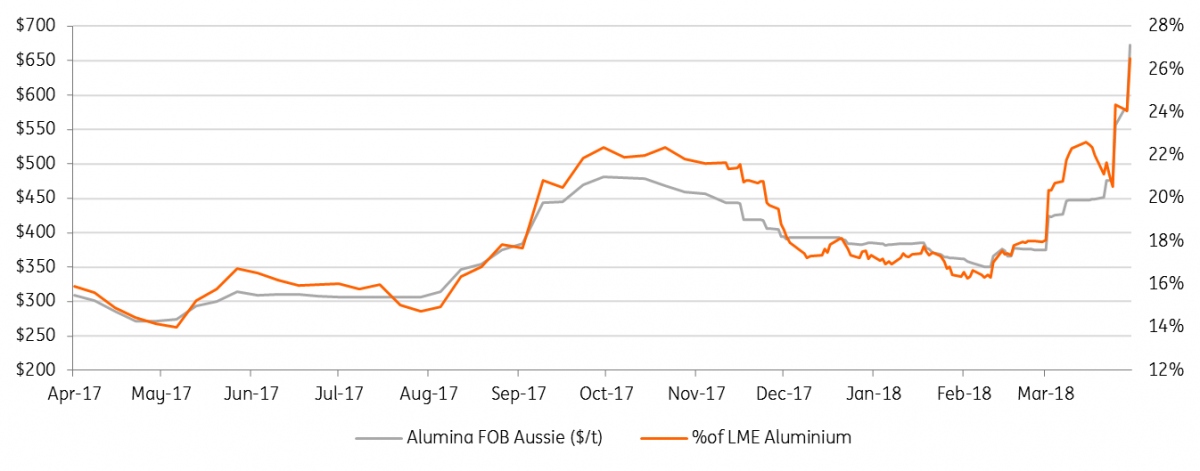Aluminium nosedives on OFAC extensions and Rusal lifeline
Aluminium prices have nosedived after the US Treasury has offered a lifeline for Rusal, saying sanctions will be lifted if Oleg Deripaska divests control. As markets weigh the probabilities that Rusal supply could fully return, the news that existing contracts are licenced to 23 October could see alumina markets through their perfect storm
A long way down, but what's for sure
Aluminium prices are in free fall following two key headlines from the US treasury department office of foreign assets control (OFAC) today. Firstly was a statement by the US Treasury that the path for providing sanctions relief (for Rusal) is the divestment and relinquishment of control of Rusal by Oleg Deripaska. Until now there has been much uncertainty whether such a move would indeed qualify for the lifting of sanctions and provide an option for Rusal production to return to the market. The guidance is now out there and an 8% sell-off in the aluminium price demonstrates the market interprets a good probability of a resolve for Rusal. We would caution it's still too early to say given the ongoing inconsistency in the US policy and the immediacy could still be lagging. Rather than focus on the will they/won't they on Rusal sanctions here we look at the far more definite the news that the US Treasury will extend the ''wind-down period" of Rusal contracts to 23 October.
The extension of the licence which was in place previously to 5 June authorises US entities to conduct activities "necessary to the maintenance or wind-down of operations, contracts, or other agreements, including the importation of goods". In short, so long as payments are delegated to blocked accounts, previously agreed supply contracts with Rusal can continue until 23 October. Previously unagreed/fresh spot business will not, therefore, be permitted. Further, the payments must be deposited into accounts blocked from 23 April, and so are unable to benefit Rusal (which had previously asked customers to stop sending payments). The confusion and added complexities (+10% duties) will still likely see some of Rusal's existing arrangements into the US already wound-down or declared force-majeure. Some resumption of flows beyond the previous June deadline will alleviate some pressure on the US premium in the near term but beyond bursting a speculative bubble the fundamental effect will be limited so long as:
1) Rusal sanctions are still coming (it's more possible now that they get lifted in the future, but nothing has changed yet)
2) Rusal spot sales to the US remain impossible
3) Section 232 will still requires midwest premiums to float c.10% above any duty-unpaid/rest of world premium (so long as the US aluminium deficit exceeds supply from those exempt countries EU, Argentina, Canada, etc).
More-so than the US, the measure could return confidence to non-US entities to deal with Rusal metal, presumably clearing trades in Euro's/non-USD currencies so as not to risk claims of breaching US Sanctions and secondary sanction retaliation. Sticking to the same rulings, however, a non-US entity still needs to be cautious about new vs existing business. We interpret this meaning just for existing contracts so any tonnage previously rejected by consumers remains walled off from the market. And there will likely still be nervousness whether non-US payments into non-blocked accounts still counts as circumvention.
Where this could have a substantial impact is if Rusal's alumina assets are able to continue operating since they do buy and sell on a contract basis. Could Rio continue to supply bauxite to Rusal's Aughinish Refinery? Can it, in turn, continue the supplies to Rio's smelters? Whilst Rusal is small on a net basis for alumina (c.210kt net sales) this is made up through substantial purchases (1.8MT) and sales (2Mt) across an interconnected supply chain. The additional Rusal disruptions have caught alumina markets in a perfect storm (on top of a 50% curtailment at Hydro's 6.2MTpa Alunorte refinery). Amid the panic-buying, these raw material prices have surged to US$700/mt, up over 50% since the end of March, or the equivalent of +US$300/t for the cost of producing 1-tonne aluminium. These hikes go beyond what many smelters can afford having issued warnings that they would have to curtail production at these prices. Any extension of Rusal alumina supply under the extended licenses will be extremely appreciated by a market in panic amidst consecutive supply outages. Come the 23 October deadline, alumina markets would likely be well better placed to weather Rusal sanctions with new contracts being formed between would be Rusal buyers and sellers, as well as the potential return of the Alunorte refinery.
Alumina caught in a perfect storm, putting global smelters under pressure (US$/mt)

This publication has been prepared by ING solely for information purposes irrespective of a particular user's means, financial situation or investment objectives. The information does not constitute investment recommendation, and nor is it investment, legal or tax advice or an offer or solicitation to purchase or sell any financial instrument. Read more
Tags
AluminiumDownload
Download snap